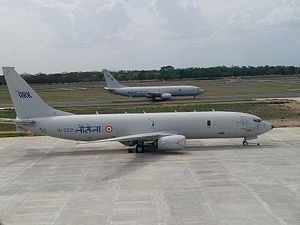Beginning on July 6, India, Japan, and the United States began the 2017 iteration of the Malabar naval exercise in the Bay of Bengal. This year’s exercise will last for eight days and have a heavy anti-submarine warfare (ASW) focus. The exercise is the second since the three countries decided that Japan would become a permanent member of what used to be a U.S.-India bilateral exercise, with other participants occasionally invited to participate or observe.
This year’s Malabar exercise is notable on several fronts. First, it’s the first naval exercise between the three countries to involve carriers from each navy. The Indian Navy has dispatched INS Vikramaditya, its modified Russian-made Kiev-class carrier that was commissioned in 2013. The United States has sent the USS Nimitz supercarrier to the exercises. Meanwhile, the Japanese Maritime Self-Defense Force sent JS Izumo, which left Japan earlier this spring for a multiple-month-long deployment to Southeast Asia before arriving in the Indian Ocean for Malabar 2017.
The Izumo is one of two Japanese warships that are among the largest the country has operated since the end of the Second World War. Japan describes the Izumo-class vessels as “helicopter destroyers” and not aircraft carriers; the warships are not equipped to launch fighter aircraft, but could likely be retrofitted for short-take-off and vertical landing (STOVL) variants of the F-35B. The Izumo is joined at Malabar 2017 by JS Sazanami; both vessels recently joined U.S. Nimitz-class supercarrier USS Ronald Reagan for bilateral exercises in the South China Sea.
Excluding the three carriers from each nation, at least fourteen other warships and submarines from the three nations are participating in this year’s exercise. Additionally, the Indian Navy has sent P-8I maritime surveillance aircraft to this exercise, underlining the anti-submarine warfare focus this year. The United States has also sent a P-8A Poseidon aircraft to the exercise.
Notably, Australia, a former Malabar participant, is not participating in Malabar 2017, despite interest from Canberra earlier this year. India and Australia held a separate bilateral naval exercise in June and the United States and Australia just concluded the latest iteration of their major bilateral exercise, Talisman Saber 2017. Australia had joined India, the United States, Japan, and Singapore for the 2007 iteration of the Malabar exercise, drawing a sharp reaction from China, which perceived the multilateral drill that year as a threatening signal of oncoming containment of its ambitions by like-minded democracies.
Malabar 2017 consists of both ashore and at-sea activities. The activities ashore, which are being held in Chennai, “include subject matter expert and professional exchanges on carrier strike group operations, maritime patrol and reconnaissance operations, surface and anti-submarine warfare, medical operations, damage control, explosive ordnance disposal (EOD), helicopter operations, and visit, board, search and seizure (VBSS) operations,” according to a statement by the U.S. Navy.
The at-sea activities include “liaison officer professional exchanges and embarks; a photo exercise; submarine familiarization; high-value unit defense; air defense exercises; medical evacuation drills; surface warfare exercises; communications exercises; search and rescue exercises; helicopter cross-deck evolutions; underway replenishments; gunnery exercises; VBSS exercises; and anti-submarine warfare.”
This year, in the weeks leading up to the Malabar drill, India and China have been locked in what has been described by the Chinese side as their most serious border incident in more than 30 years. Indian and Chinese soldiers have been involved in a tense stand-off in a piece of territory disputed between Bhutan and China to which India ascribes strategic importance.
The anti-submarine warfare focus of this year’s Malabar also carries subtext given the ever-increasing and regular operation of Chinese People’s Liberation Army-Navy submarines in the Indian Ocean. Since 2015, at least, Chinese Shang-class and Song-class submarines have been deployed in the Indian Ocean, raising concerns for India. China has, in the meantime, also broken ground on its first overseas naval base in Djibouti.
Listen to a recent episode of the Diplomat’s podcast on Asian geopolitics for the significance of this year’s Malabar exercises.

































